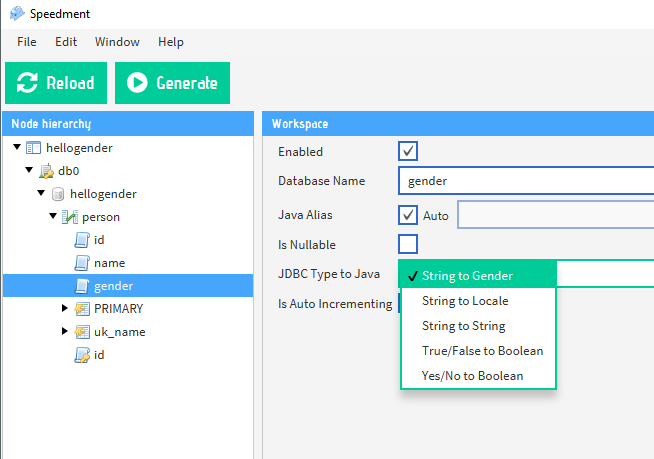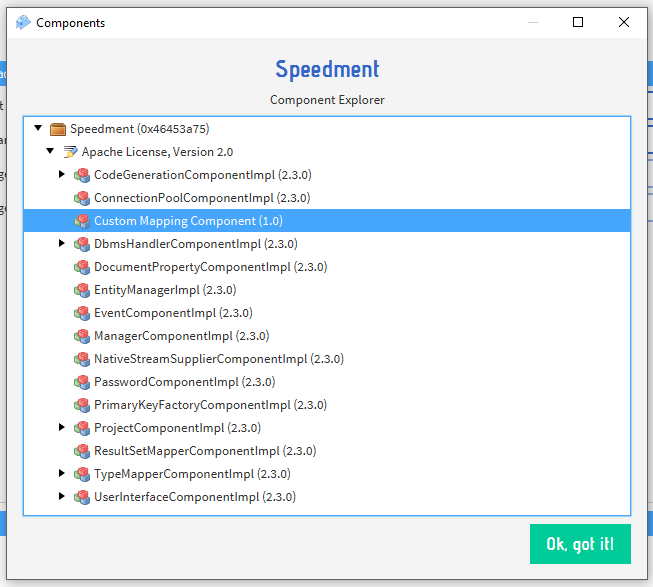Tutorial: Plug in a Custom TypeMapper
Say that you have a database with a table "user" which has a column "gender", and you want that implemented as an enum in java. If you run Speedment and use it to generate code, the "gender" field will be represented as a String. The reason for this is that there aren’t any built-in mappers for converting between database ENUMs and custom Java classes. This is one of those cases when you might feel that the generator is taking away control for you. Well, fear not, for you can get this same control by creating your own plugin for Speedment!
In this example, we have a database schema with a table called "Person". A person has an id, a name, and a gender. The gender is declared as an ENUM with three possible values: "Male", "Female" and "Other". If we use the default settings in Speedment to generate this class, Speedment will consider the ENUM a String. Although, there are some issues with this. For an example, if you want to persist a new person into the database, there is nothing that prevents you from spelling a gender wrong and getting an exception when you do the insert. Instead, we want to define a java enum with the specified alternatives as constants. What would make the generated code more secure and easier to use.
We can achieve this using a plugin for Speedment!
To do any custom modifications to the Speedment platform we will need to define a plugin. A plugin is a piece of software that can be plugged into the Speedment runtime from the pom.xml-file. The plugin resides in its own maven project and can be shared between projects.
Begin by creating a new Maven Project and declare the Speedment generator as a dependency. You will not need the speedment-maven-plugin in this project.
<dependency>
<groupId>com.speedment</groupId>
<artifactId>generator</artifactId>
<version>${speedment.version}</version>
<type>pom</type>
</dependency>A Component is a pluggable piece of software that can be executed as part of the Speedment lifecycle. Every component has a number of stages in which it is allowed to execute. These are "initialize", "resolve" and "start".
@InjectKey(CustomMappingComponent.class)
public final class CustomMappingComponent {
@ExecuteBefore(RESOLVED)
public void onResolve(@WithState(INITIALIZED) TypeMapperComponent typeMapper) {
typeMapper.install(String.class, StringToGenderMapper::new);
}
}We now have a bare-bone plugin that can be added to a Speedment project. The next step is to define the logic that maps between strings and genders. To do this, we need the Gender enum.
public enum Gender {
MALE ("Male"),
FEMALE ("Female"),
OTHER ("Other");
private final String databaseName;
Gender(String databaseName) {
this.databaseName = databaseName;
}
public String getDatabaseName() {
return databaseName;
}
public static Gender ofDatabaseName(String name) {
for (Gender gender : values()) {
if (gender.databaseName.equals(name)) {
return gender;
}
}
throw new UnsupportedOperationException(
"Unknown gender '" + name + "'."
);
}
}If you store the enum values in upper-case in the database, this class could be much shorter since you could simply use the Enum.name()-method to get the database name, but this approach is better if you want flexibility in naming the constants.
Now for the final piece. We need to declare a type that implements the TypeMapper-interface in Speedment. A type mapper is really simple. It contains two methods for mapping to and from the database type as well as methods for retrieving the java type and label for the mapper.
public final class StringToGenderMapper implements TypeMapper<String, Gender> {
@Override
public String getLabel() {
return "String to Gender";
}
@Override
public Type getJavaType(Column column) {
return Gender.class;
}
@Override
public Gender toJavaType(Column column, Class<?> aClass, String value) {
return value != null ? Gender.ofDatabaseName(value) : null;
}
@Override
public String toDatabaseType(Gender value) {
return value != null ? value.getDatabaseName() : null;
}
}Our new plugin is now done! Build the project and you are set to go!
To use a plugin in a project, you only need to modify the pom.xml-file of that project. Open up an existing Speedment project and locate the pom.xml-file. In it, you should be able to find the speedment-maven-plugin. To make your own plugin accessible for the maven plugin, you need to add it as a dependency inside the <plugin>-tag and add the ComponentInstaller to the configuration. Here is an example of how it can look:
<plugin>
<groupId>com.speedment</groupId>
<artifactId>speedment-maven-plugin</artifactId>
<version>3.2.10</version>
<dependencies>
<dependency>
<groupId>mysql</groupId>
<artifactId>mysql-connector-java</artifactId>
<version>${mysql.version}</version>
</dependency>
<!-- Our plugin project -->
<dependency>
<groupId>com.github.pyknic</groupId>
<artifactId>custom-mapping-component</artifactId>
<version>1.0.0-SNAPSHOT</version>
</dependency>
</dependencies>
<configuration>
<components>
<!-- Path to the component installer -->
<component>com.github.pyknic.salesinfo.plugin.CustomMappingComponent</component>
</components>
</configuration>
</plugin>You also need to add the project as a runtime dependency since the new Gender-enum must be accessible from the generated code.
<dependencies>
...
<dependency>
<groupId>com.github.pyknic</groupId>
<artifactId>custom-mapping-component</artifactId>
<version>1.0.0-SNAPSHOT</version>
</dependency>
...
</dependencies>That’s it! The plugin is installed! If you want to a particular column to be mapped to a Gender instead of a String, you can go into the User Interface, navigate to the particular column in the "Project Tree" and select your new Type Mapper in the dropdown list.

If you want to see a list of all the components and/or type mappers loaded into the platform, you can also go to "Help" → "Components..." in the UI. There you should see the new component.

In this article, you have learned how to create a custom plugin for Speedment that integrates a new Type Mapper from a String to a Gender enum. You have also learned how you can see which components are loaded into the platform and select which type mapper you want to use for each column.
PS: If you create some cool new mappers for your Speedment project, consider sharing them with the community in our Gitter chat!
Speedment is available under the Apache 2 license.
Want to learn more about the enterprise version? Visit www.speedment.com!